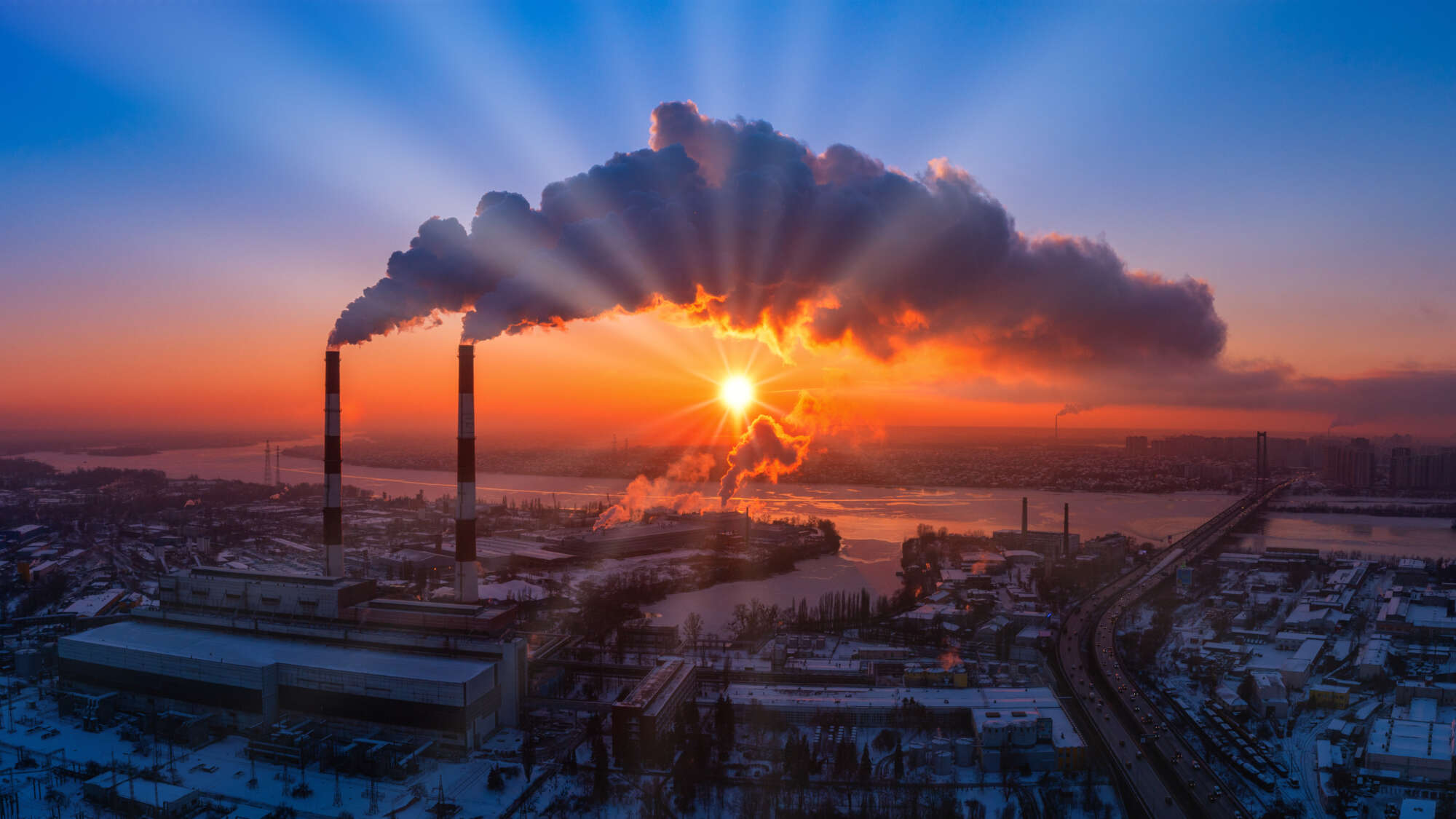The debate about whether climate change is a real phenomenon – and whether humankind is responsible for the alarming rise in greenhouse gas (GHG) levels – is largely a thing of the past. Three decades of research has put forth what most scientists consider incontrovertible proof that escalating levels of carbon dioxide (CO2), methane (CH4), and nitrous oxide (N2O) are a direct result of human activities ranging from deforestation to emissions from energy production, industry, and agriculture.
Yet while we’ve achieved causal consensus, controversy remains on the best path forward. Today’s discussions around climate change center on finding workable solutions, while at the same time, more and more evidence turns up surrounding active negative impacts on human health.
It Takes a World View
Health has always been at the fore of the climate change conversation. To tackle the problem, the Intergovernmental Panel on Climate Change (IPCC) was created in 1988 by the World Meteorological Organization (WMO) and the United Nations Environment Programme (UNEP). With 195 members, the IPCC is an organization of governments that brings together hundreds of the world’s foremost experts on climatology to provide stakeholders with scientific information they can use to develop climate policies and contribute to international climate change negotiations.
IPCC’s first Climate Change Assessment Report, released in 1990, spelled out multiple effects of climate change with the potential to undermine human health. At the top of the list were reduced air and water quality, heat stress, and a rapid uptick in vector-borne disease transmission. Since that time, across multiple Assessments, the Panel has produced a growing body of evidence that proves the veracity of Global Warming. Concurrently, the public health community has produced numerous studies on the myriad ways in which minute changes in temperature may be having catastrophic effects on health. As part of its Sixth Climate Change Assessment published in April of this year, IPCC presented a graph showing stark evidence of atmospheric carbon dioxide levels based on observations recorded at Mauna Loa Volcanic Observatory in Hawaii (Figure 1).
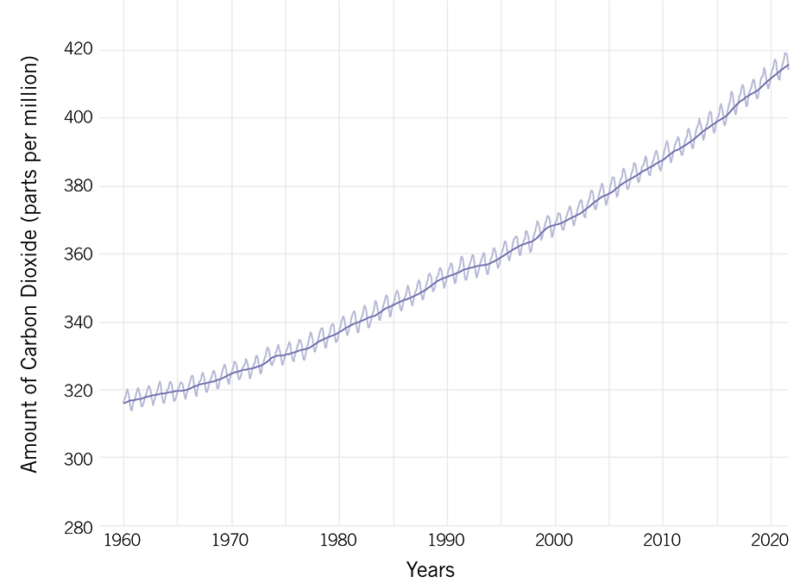
Sources: Intergovernmental Panel on Climate Change; National Oceanic and Atmospheric Administration
Evidence suggests that for almost 6,000 years of human civilization prior to the Industrial Revolution, atmospheric CO2 levels were consistently around 280 parts per million (ppm). By the time continuous observations began at the Mauna Loa Observatory in 1958, atmospheric CO2 was already measured at 315 ppm. This graph shows the station’s monthly average carbon dioxide measurements since 1960, with the seasonal cycle of highs and lows (small peaks and valleys) driven by summertime growth and winter decay of Northern Hemisphere vegetation. The long-term trend of rising carbon dioxide levels is driven by human activities. In May 2022, atmospheric CO2 peaked at 421 ppm, higher than at any point in human history.
GHGs: Sources and Weather Effects
At their core, GHGs are not a bad thing. In fact, they are a necessary cog in our ecosystem. Light energy from the sun passes through the atmosphere, with about half of it making it all the way to the Earth’s surface. There, it is absorbed and then radiated outward as heat. GHGs capture and absorb as much as 90% of this heat, preventing it from dissipating into space. Without GHGs, scientists estimate the Earth’s average temperature would be as low as –18˚C (–0.4˚F).1
In addition to CO2, methane, and nitrous oxide (released from nitrogen fertilizers and crop burndown in agriculture), GHGs include natural water vapor, ozone (O3), and a small amount of synthetic fluorinated gases (see Figure 2). Of GHGs created by man, carbon dioxide accounts for about 76% and is considered the main driver behind global warming.2 Carbon emissions are generated from the burning of fossil fuels (mainly from power plants and transportation), releasing carbon which then combines with oxygen in the air to form CO2 and water vapor.
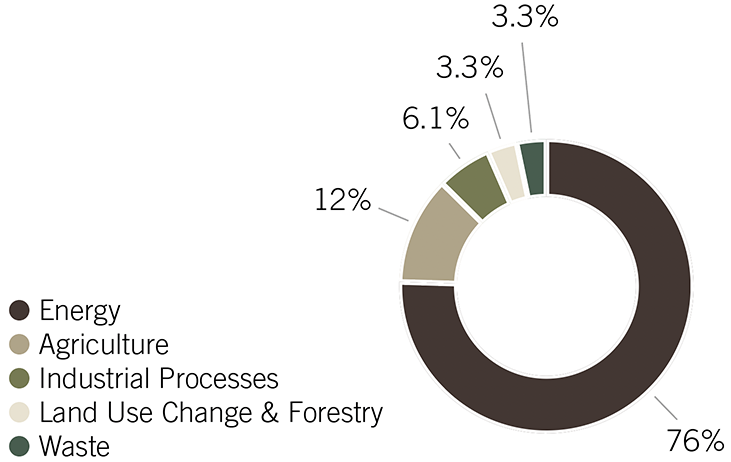
Source: Climatewatch.org
According to climate.gov, if global energy demand continues its current growth path and is met mostly with combustion of fossil fuels; human emissions of carbon dioxide could reach 75 billion tons per year (or more) by the end of the century and atmospheric CO2 concentration could reach an 800 ppm or higher.
As GHG concentrations rise, so does the Earth’s temperature. Climatologists report that going back to the 1980s, each decade has been warmer than the decade before. These changes result in numerous effects that can impact human health:
Heat waves: High temperatures make outdoor activities a challenge and increase the incidence of heat-related illnesses.
Wildfires: Hot conditions are ideal for the ignition and rapid spread of wildfires – threatening wildlife, human habitations, and severe economic loss.
Severe Storms: Highly destructive storms such as cyclones, hurricanes, and typhoons have become more frequent and intense in many regions. Extreme rainfall causes flooding, often with devastating effects.
Drought Conditions: Higher temperatures also promote drought conditions in many regions, adversely impacting food production and water availability in developing countries. Earth.org reports that the Sahara Desert is expanding at the rate of 48km per year.
Rising, more Acidic Oceans: Most of the heat from global warming is absorbed by the world’s oceans. And as water heats up, it expands, causing sea levels to rise. The National Ocean Service reports that sea levels are rising at the rate of 1/8 inch (3.2mm) per year, and that in 2014, global sea level was 2.6 inches higher than the 1993 average.
Global Hunger: Climate changes and extreme weather events contribute to a rise in hunger and poor nutrition in many regions. Crop production, livestock production, and fisheries all face production challenges stemming from higher temperatures. As increased carbon dioxide makes the ocean more acidic, marine life (an important food source) is endangered.
Other Health Risks: Climate change contributes to air pollution, displacement from extreme weather events, pressures on mental health, increased hunger and poor nutrition, and an increase in vector-borne disease. Collectively, these challenges negatively impact health care system capacity and exhaust valuable resources.
Climate change is the single biggest health threat facing humanity.
World Health Organization
Linking Climate Change to Health
As is often the case in biostatistics, the complex amalgam of variables, dependencies, and interactions makes deep analysis of the relationship between climate change and health impacts challenging to calibrate (see Figure 3). The one glaring Public Health constant linking vulnerability to the disadvantaged is far easier to recognize, as the extent of impact is often directly proportional to one’s ability to prepare and respond.3 According to the World Meteorological Organization, weather-related events displaced an average of 23.1 million people per year between 2010 – 2019/. The World Health Organization (WHO) indicates that between 2030 and 2050, climate change will cause approximately 250,000 additional deaths per year, stemming from malnutrition, malaria, diarrhea, and heat stress. Direct damage costs to health (excluding health-determining sectors such as agriculture and water and sanitation), is expected to reach between USD 2-4 billion/year by 2030.4
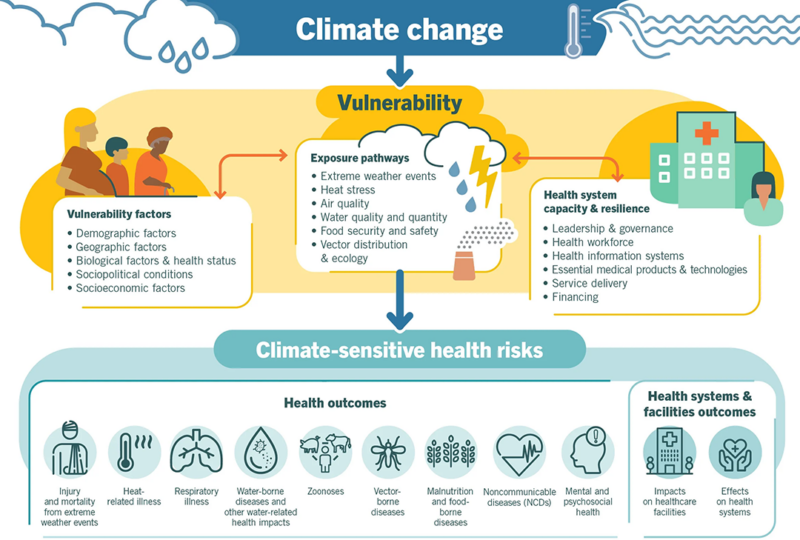
Source: World Health Organization
Despite the challenge of quantifying these impacts, interesting new research has emerged from the Lab of Camilo Mora, Ph.D., and the Department of Geography and Environment at the University of Hawaiʻi, Mānoa. In the September 2022 issue of Nature Climate Change, a study (“Over Half of Known Human Pathogenic Diseases can be Aggravated by Climate Change”) by Mora and his team investigates the link between climatic hazards arising from GHG emissions (i.e. warming, heatwaves, drought, wildfires, extreme precipitation, floods, rising sea level, etc.) with human pathogenic disease.5 Through a series of complementary literature searches examining 77,000 titles, the group found more than 3,213 empirical examples in which climactic hazards were linked to pathogenic diseases. Pairing these examples against a list of 375 pathogenic diseases with demonstrated human impact, Mora found that 218 of the diseases (58%) were aggravated by one or more of the climatic hazards associated with climate change.
Mora writes that “While numerous biological, ecological, environmental, and social factors contribute to the successful emergence of a human pathogenic disease; at the most basic level, it depends on a pathogen and a person coming into contact, and the extent to which peoples’ resistance is diminished, or the pathogen is strengthened, by a climatic hazard
Empirical cases revealed 1,006 unique pathways in which climatic hazards, via different transmission types, led to pathogenic diseases. The human pathogenic diseases and transmission pathways aggravated by climatic hazards are too numerous for comprehensive societal adaptations, highlighting the urgent need to work at the source of the problem: reducing GHG emissions.” See Figure 4.
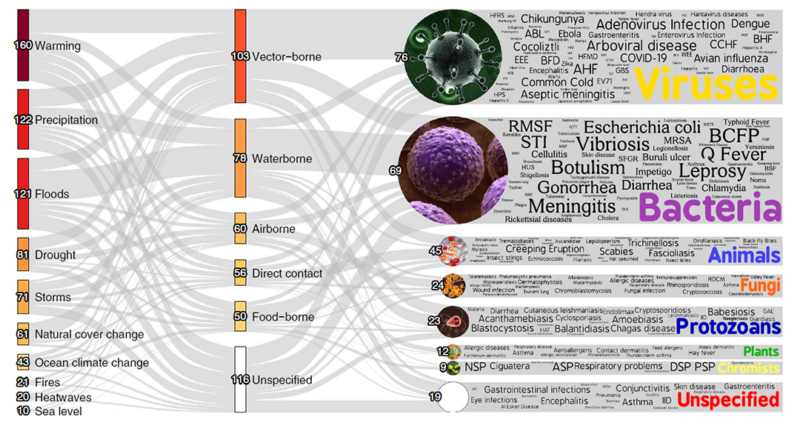
Mora’s graphic displays the pathways in which climatic hazards, via specific transmission types, result in the aggravation of specific pathogenic diseases. The thickness of the lines is proportional to the number of unique pathogenic diseases. The color gradient indicates the proportional quantity of diseases, with darker colors representing larger quantities and lighter colors representing fewer. Numbers at each node are indicative of the number of unique pathogenic diseases. Several disease names were abbreviated to optimize the use of space in the figure. An interactive display of the pathways and the underlying data can be found at https://camilo-mora.github.io/Diseases/
Source: Mora, C., McKenzie, T., Gaw, I.M. et al
Not surprisingly, Mora et al. found that warming and precipitation change were associated with range expansion of disease vectors such as mosquitoes, ticks, fleas, birds, and several mammals implicated in outbreaks by viruses, bacteria, animals, and protozoans including dengue, West Nile virus (WNV), chikungunya, Lyme disease, Zika, and malaria, among others. Warming at higher latitudes allowed vectors and pathogens to survive winter, aggravating outbreaks by several viruses, while drought caused congregation of mosquitoes and birds around remaining water sources, facilitating transmission of WNV. Floods and storms were commonly associated with wastewater overflow, leading to direct and foodborne transmission of multiple pathogens.
Mitigation Challenges
Despite the scope and urgency of these dynamics, the future for climate change countermeasures remains murky at best. IPCC’s latest report discusses a variety of means by which climate change might be addressed. Above all, the report emphasizes the need to employ an integrated approach to reducing GHGs. While carbon emissions are clearly the main driver, a reduction of atmospheric CO2 could theoretically be achieved in one of two ways: 1) reduce carbon emissions; 2) increase CO2 extraction. The latter, however, generates quite a bit of controversy among policy makers and scientists. Although the IPCC states that CO2 extraction will be necessary to reverse the climate change curve before the end of the century, detractors claim these technologies create a distraction from the more urgent need of reducing carbon emissions.
Nonetheless, a 2018 study published by the National Academy of Sciences (NAS) points to several “negative emissions” technologies it claims are ready to be deployed on large scale.6 One involves increasing the amount of sea coast marshlands and estuaries, which are capable of storing more carbon by area than any other ecosystem on Earth. NAS claims that increasing these areas could nearly double the amount of carbon currently being extracted. Unfortunately, these habitats are among the Earth’s most challenged – already declining by between 500,000 to a million hectares per year
Dramatic changes to agricultural practices offer another opportunity for negative emissions. Planting cover crops to fix nitrogen – and reducing tillage and crop burndown, for example – can reduce our need to apply nitrogen-based fertilizer. Another idea in the agriculture space involves growing energy crops that can be combusted in lieu of fossil fuels to create electricity. The CO2 from this combustion could be captured and buried underground. The downside to this innovation is that it would require an area of about 3 times the size of India to be devoted to such crops – equivalent to 40% of all the world’s cropland.
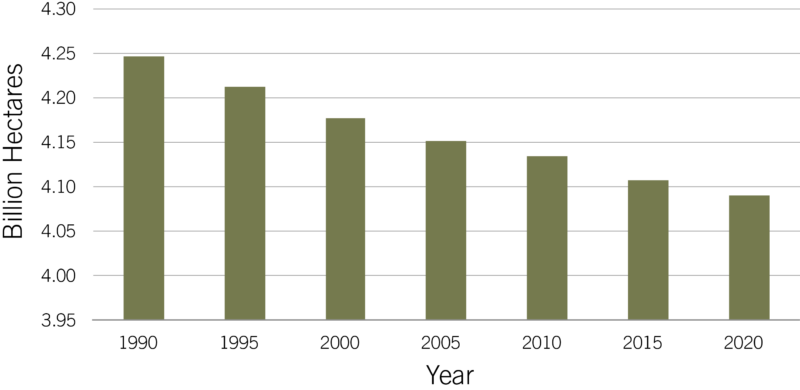
Source: UN Food and Agriculture Organization
The NAS report also states that to achieve the Paris Agreement (a legally binding international treated signed by 196 parties in 2015) target of a less than 2°C increase in average temperature by the turn of the century, 20 billion tonnes of CO2 would need to be removed from the atmosphere every year until 2100. But these and other extraction technologies would remove significantly less than 10.
Deforestation is another contributing factor to climate change, as trees serve as nature’s sequestration backbone within the carbon cycle. Columbia Climate School estimates that forests have the potential of storing almost 25% of all the carbon needed to achieve the <2°C increase objective.7 But at the same time humanity delivers its excess of emissions, it also strips away millions of acres of forested lands each year. Between 1990 and 2020, the world’s forested area declined by a startling 180 million hectares (445 million acres), or about 15 million acres per year (see Figure 5). Contrary to popular opinion, this decline does not stem from the lumber industry – where reforestation is fundamental to operations and long-term profitability. Rather, forest lands are being converted for use in agriculture or urban development as the global population continues to rise.
Open Letter Calls for Action
With clear insights into cause and a growing understanding of real and potential effects, the 2021 United Nations climate negotiations held in Glasgow (COP26) created a new opportunity to provoke change. Over 600 organizations representing over 46 million health workers, together with over 3,400 individuals from 102 different countries, signed an open letter to national leaders and country delegations, calling for real action to address the climate crisis by limiting global warming to 1.5°C, and to make human health and equity central to all climate change mitigation and adaptation actions.
Let’s hope it doesn’t fall on deaf ears.
1. https://education.nationalgeographic.org/resource/greenhouse-effect-our-planet
2. https://www.nrdc.org/stories/greenhouse-effect-101#gases
3. https://www.who.int/health-topics/climate-change
4. https://public.wmo.int/en/media/press-release/climate-change-indicators-and-impacts-worsened-2020,/br>5. National Academies of Sciences, Engineering, and Medicine. 2019. Negative Emissions Technologies and Reliable Sequestration: A Research Agenda. Washington, DC: The National Academies Press. https://doi.org/10.17226/25259
6. Mora, C., McKenzie, T., Gaw, I.M. et al. Over half of known human pathogenic diseases can be aggravated by climate change. Nat. Clim. Chang. 12, 869–875 (2022). https://doi.org/10.1038/s41558-022-01426-1
7. https://news.climate.columbia.edu/2021/09/23/natural-climate-solutions-why-we-need-them
